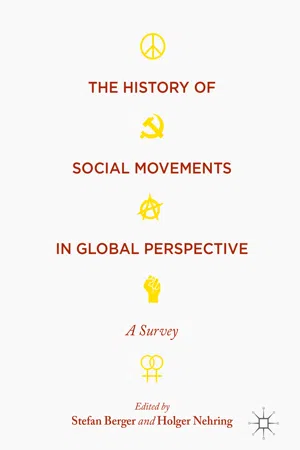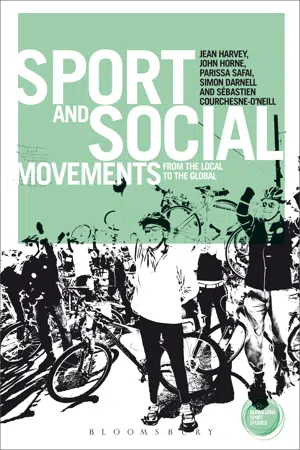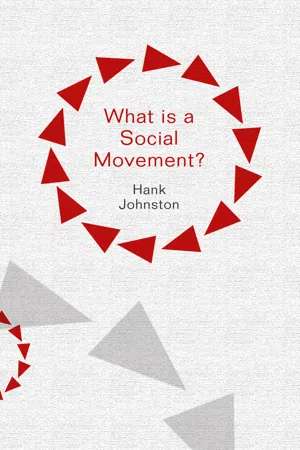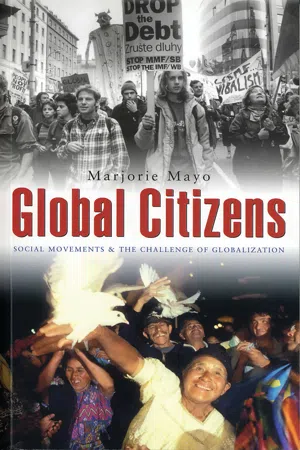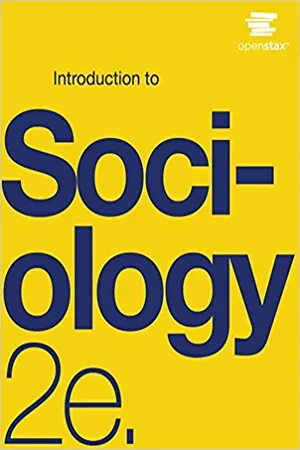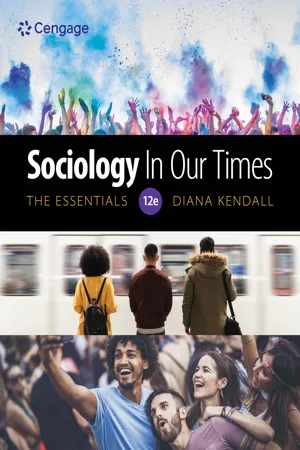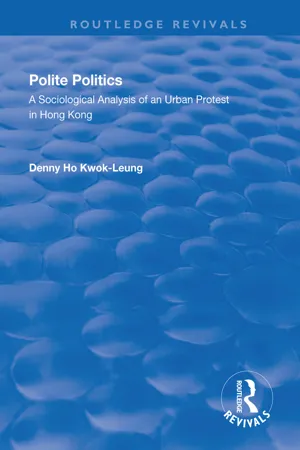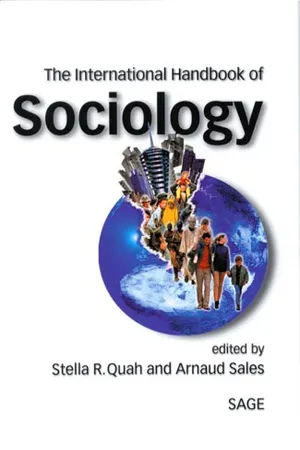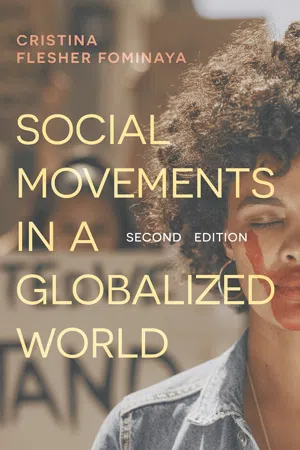Social Sciences
Social Movements and Social Change
Social movements are collective efforts by a group of people to bring about social, political, or cultural change. They often arise in response to perceived injustices or inequalities and seek to challenge existing power structures. Through various forms of activism, social movements aim to raise awareness, mobilize support, and ultimately influence policies and societal norms.
Written by Perlego with AI-assistance
Related key terms
1 of 5
12 Key excerpts on "Social Movements and Social Change"
- eBook - PDF
- Stefan Berger, Holger Nehring, Stefan Berger, Holger Nehring(Authors)
- 2017(Publication Date)
- Palgrave Macmillan(Publisher)
The aim to bring about, or resist, social change is a crucial defini- tional element. What is meant here is not any minor change in society but rather fundamental change of society. Obviously, what ‘fundamental’ means in this context needs to be clarified. In a preliminary take, funda- mental change refers, first, to the basic patterns of distribution of power and material resources in a given society and, second, to the values and justifications for maintaining this order. Depending on the context, social movements may promote values that are opposed to the dominating ones, as was the case when liberal bourgeois movements questioned the values 7 Tilly defines a social movement as ‘a series of contentious performances, displays and campaigns by which ordinary people make collective claims on others’ (Charles Tilly, Social Movements, 1768–2004 [Boulder, CO: Paradigm Publishers, 2004], p. 3). He argues that social movements include three basic elements: campaigns, a repertoire of contention and WUNC: participants’ concerted public representation of worthiness, unity, numbers and commitments on the part of themselves and/or their constituencies. 8 See, for example, Mario Diani, ‘The Concept of Social Movement’, The Sociological Review 40 (1992), pp. 1–25; Donatella della Porta and Mario Diani, Social Movements: An Introduction , 2nd rev. edn (Oxford: Basil Blackwell, 2006); Joachim Raschke, Soziale Bewegungen. Ein historisch-systematischer Grundriß (Frankfurt/New York: Campus, 1985); Dieter Rucht, Modernisierung und neue soziale Bewegungen. Deutschland, Frankreich und USA im Vergleich (Frankfurt/Main: Campus Verlag, 1994). 9 Tarrow, for example, defines social movements as ‘socially mobilized groups engaged in sustained contentious interaction with powerholders in which at least one actor is either a target or a participant’. - eBook - ePub
Sport and Social Movements
From the Local to the Global
- Jean Harvey, John Horne, Parissa Safai, Simon Darnell, Sebastien Courchesne-O'Neill(Authors)
- 2013(Publication Date)
- Bloomsbury Academic(Publisher)
1 Analysing Sport and (Global) Social Movements A s noted in the introduction, the term ‘social movement’ has been used quite loosely in both academic and popular discourse. In this chapter we discuss how the concept of ‘social movement’ has been understood and debated in academic literature in order to contextualize our use of the term in this book. For us, ‘movement’ implies a change over space and time; a relocation from one place to another and talk of social movements refers to the historical agency of social classes and other social collectivities in the shaping of society. Simply put then for us a social movement combines the idea of change with the notion of a strategy or intentionality and the coming together of dominated or minority social groups in efforts at social transformation (Bennett et al. 2005, pp. 224–5). Some writers about sport and society, for example, Jarvie with Thornton (2012, pp. 381ff), have suggested that sport itself should be considered as a social movement. From their viewpoint, in its organized form, it has characteristics such as informal interaction networks, shared beliefs and organizational goals that can be found in other social movements. We argue that such a broad and inclusive definition is too imprecise to help understand the differences between movements that have a progressive social agenda and those that do not, which includes several so-called ‘movements’ within sport. As we demonstrate in this book, rather than positioning sport itself as a social movement, it is more accurate to state that sport has often had a connection to social movements and social movements have influenced sport. For example, in Chapter 3 we show how various forms of the women’s rights movement and of feminism have influenced the development of a global women’s sport movement - eBook - ePub
- Hank Johnston(Author)
- 2014(Publication Date)
- Polity(Publisher)
2 The Study of Social MovementsThis chapter tells a story of how an important field of study in the social sciences, one that spans sociology, political science, and social psychology, grew to maturity in the last half-century. In the United States, its adolescence was tumultuous, commencing amidst the numerous protests and social movements of the 1960s. The movements of that decade kindled widespread research attention to collective action, protest, social-change groups and their organization, and inspired a generation of scholars to systematically and empirically study these phenomena. Researchers sought to explain the black civil rights movement, the movement against the war in Vietnam, the women's movement, environmentalism, the Chicano movement, the new age movement, the hippie movement, student political radicalism, and political violence.There is a related story that will be also told in these pages: the honing of the tools of social science to study social movements and protest. In the 1960s, theorizing about collective behavior and social movements was less grounded in empirical research. At its best, it was based on systematic observation, informed reasoning, and logical deductions about causes and connections among apparently related phenomena. Many of the ideas were good ones, but that by itself does not make social science. This chapter traces how a field of research came of age as a community of scholars worked to refine theory using increasingly sophisticated research tools. In the US, a critical mass of social movement researchers was reached sometime around the mid-1970s, and their concepts, findings, methods, and debates took off exponentially thereafter. Today, the study of protests, social movements, and contentious politics is a major research focus in both North America and Europe, and its influence continues to grow. - eBook - ePub
Global Citizens
Social Movements and the Challenge of Globalization
- Marjorie Mayo(Author)
- 2013(Publication Date)
- Zed Books(Publisher)
Eyerman and Jamison 1991 : 4), although others have seen social movements as more durable phenomena.In addition, the four social movement themes that have been identified by Della Porta and Diani have relevance, to add to these varying definitions. These themes include informal interaction networks (as well as more formal ones, because formal organizations such as churches, trade unions and political parties can and do participate in social movements too) based upon shared beliefs and solidarity , engaging in collective action with a focus upon conflicts, and including the use of protest (Della Porta and Diani 1999 ). As Della Porta and Diani also recognize, however, shared beliefs and solidarity are not simply to be taken as givens in social movements. There are two-way processes at work here, as individuals and groups join on the basis of shared beliefs, which may then become strengthened through processes of participation in collective action and collective reflection on these shared experiences. As the previous chapter suggested, adult and community education perspectives may be of relevance here, focusing on the potential for experiential learning, backed by critical analysis, enabling social movement participants to strengthen their shared understandings of the causes as well as their shared commitments to the resolution of the issues around which they mobilize (Holst 2002 ).Such approaches to the definition of social movements could encompass a very wide range of mobilizations. The women’s movement and environmental and green movements would be included, for instance, together with movements for peace, civil liberties and human rights (including rights to self-determination and respect for a range of minorities – and indeed majorities in the case of the women’s movement). The trade union and labour movement would also be included, comprising, as it does, a range of networks and adherents, over and above the paid-up members of any particular constituent organization. So would fascist movements, as well as anti-fascist and anti-racist movements (there being nothing inherently progressive about social movements per se), pro- and anti-abortion movements and animal rights movements. All of these could be described as comprising networks sharing beliefs and solidarity, with commitments to collective action, including the use of varying forms of protest (whether violent and/or non-violent). - eBook - PDF
- Heather Griffiths, Nathan Keirns, Eric Strayer, Susan Cody-Rydzewski, Gail Scaramuzzo, Tommy Sadler, Sally Vyain, Jeff Bry, Faye Jones(Authors)
- 2015(Publication Date)
- Openstax(Publisher)
21 Social Movements and Social Change Figure 21.1 In many ways, this mask, which perhaps became infamous due to its use by the "hacktivist" group Anonymous, has come to stand for revolution and social change around the world. (Photo courtesy of Coco Curranski/flickr) Learning Objectives 21.1. Collective Behavior • Describe different forms of collective behavior • Differentiate between types of crowds • Discuss emergent norm, value-added, and assembling perspective analyses of collective behavior 21.2. Social Movements • Demonstrate awareness of social movements on a state, national, and global level • Distinguish between different types of social movements • Identify stages of social movements • Discuss theoretical perspectives on social movements, like resource mobilization, framing, and new social movement theory 21.3. Social Change • Explain how technology, social institutions, population, and the environment can bring about social change • Discuss the importance of modernization in relation to social change Chapter 21 | Social Movements and Social Change 475 Introduction to Social Movements and Social Change Perhaps the social movement that ran the most contrary to theory in recent history is Occupy Wall Street (OWS). Although it contains many of the classic developmental elements of a social movement we will describe in this chapter, it is set apart by its lack of a single message, its leaderless organization, and its target—financial institutions instead of the government. OWS baffled much of the public, and certainly the mainstream media, leading many to ask, "Who are they, and what do they want?" On July 13, 2011, the organization Adbusters posted on its blog, "Are you ready for a Tahrir moment? On September 17th, flood into lower Manhattan, set up tents, kitchens, peaceful barricades and occupy Wall Street" (Castells 2012). - eBook - PDF
- Chris Rumford(Author)
- 2009(Publication Date)
- SAGE Publications Ltd(Publisher)
Changes in the nature of the conflict are also reflected in the characteristics of the new actors. In contrast with the labour movement, social movements develop a fundamental, SOCIAL MOVEMENTS 367 metapolitical critique of the social order and representative democracy, challenging insti-tutional assumptions regarding conventional ways of ‘doing politics’, in the name of a radical democracy (Offe, 1985). Among the principal innovations, in contrast with the workers’ movement, are a critical ideology in relation to modernism and progress; decen-tralized and participatory organizational structures; defence of interpersonal solidarity against state and corporate bureaucracies; and the reclamation of autonomous spaces, rather than material advantages. Inspired by Pierre Bourdieu, European sociologists also engaged in the analysis of cultural habits (or the cultural predispositions produced by processes of socialization) as well as their structural determinants. Attention has been paid to the cultural meanings (or habitus) within the specific fields of social action to which individuals belong: ‘Going beyond economic interests, some scholars explained indeed social movement activism as following needs and desires that derive from values and norms that are typical of specific cultures (or fields)’ (della Porta and Diani, 2006). New social movements’ approaches have been criticized on various grounds. First – looking especially at the evolution of the environmental or women’s movements – the very concept of ‘new social movement’ tended to be constructed around historically contingent characteristics (such as informal organization or a focus on non-material issues) taken as general defining traits of social movements (della Porta and Diani, 2006: chapter 1). - eBook - PDF
- Diana Kendall(Author)
- 2020(Publication Date)
- Cengage Learning EMEA(Publisher)
Chapter Review ■ 511 content with their status. According to value-added theory, six conditions are required for a social movement: (1) a perceived problem, (2) a perception that the authorities are not resolving the problem, (3) a spread of the belief to an adequate number of people, (4) a precipitating incident, (5) mobilization of other people by leaders, and (6) a lack of social control. By contrast, resource mobilization theory asserts that successful social movements can occur only when they gain the support of political and economic elites, who provide access to the resources necessary to maintain the movement. Research based on social constructionist theory uses frame analysis, which often focuses on how people use social interactions to socially construct their grievances and to determine what they think should be done to resolve them. By contrast, research based on political opportunity theory identifies reasons why social protests are most likely to occur when potential protesters and movement organizers perceive that limited opportunities exist for them within the political system. Finally, research based on new social movement theory looks at various identity factors of potential protesters, including their race, class, gender, and sexuality, to help explain why collective action and social movements emerge ( for example, people who believe that they have experienced environmental racism because of their race/ethnicity and class). LO7 What has been the past, present, and future of social change? Throughout history, social change has been rooted in changes in the physical environment that produce changes in the lives of people. Social change has also been related to changes in population size, distribution, and composition because these affect the culture and social structure of a society and change the relationships among nations. - eBook - ePub
Polite Politics
A Sociological Analysis of an Urban Protest in Hong Kong
- Denny Ho Kwok-leung(Author)
- 2018(Publication Date)
- Taylor & Francis(Publisher)
2 Theories of Social Movements: A Review of the LiteratureIntroduction
The study of social movements became popular in the 1960s, an era in which protests and direct actions outside the formal political system played an important role in social change. This led to a growth in the general sociology literature of work informed by resource mobilization theories which considered protests and social movements to be the products of the political participation of rational people. This view is contrary to that offered by the dominant classical perspective which deemed collective action to be initiated by irrational people. Resource mobilization theorists emphasize the study of the process of collective actions and their impacts on social change. In urban sociology, Pickvance (1977) suggested that it might be fruitful to adopt this perspective to study the process of translating a social base to a social force. The study of this aspect in urban sociology seems necessary since the development and dynamics of urban movements have received little attention (Hannigan, 1985). Later Pahl (1989) in his evaluation of class analysis pointed out that the analysis of urban movements often invoked a structure-consciousness-action chain to theorize its origin, but had in practice given little attention to the mechanisms by which the social group in question acquired the 'consciousness' that guided and informed its actions. Despite such awareness of the need to study the relationship between action and structure, little effort has been put into this question (Giddens, 1984).This chapter reviews the existing literature on social movements, and in doing so brings out the main theoretical issues concerning the analysis of urban movements. Our aim is to develop a more useful and coherent theoretical framework to understand urban movements in a specific social and political context. Another objective of this chapter is to bring out the theoretical issues pertinent to the analysis of locally based urban movements. We shall argue that the strategy of an urban movement is an adequate dependent variable, and that the analysis of the process of its formulation and implementation is the key to unravelling the complexity and dynamics of urban movements. We shall start with a brief review of the classical perspective on collective action in section 2.1. Section 2.2 discusses the resource mobilization perspective. Although there are problems in this perspective, we shall draw on the analytical classification of resource acquisition for the study in this thesis. In sections 2.3 and 2.4, we explore and examine two recent theoretical models, that is, the political process model and the social construction of protests, and try to show that these two models are complementary to the resource mobilization perspective. At the end of each section, we point out the major shortcomings of the perspectives. In section 2.5, we link up the resource mobilization perspective with the political process and social construction models, and illustrate a possible way of using their conceptual and analytical elements in our analysis of social movements. - William Sims Bainbridge, William S. Bainbridge(Authors)
- 2011(Publication Date)
- SAGE Publications, Inc(Publisher)
Social Movements A huge literature exists concerning two general categories of social movement, religious movements and political movements , but only modest and poorly organized litera-tures are available about many other areas of human life where movements are often significant. One reason is that the consolidation of collective behavior into formal move-ments is obvious in these two domains, and the result may be a legally registered religious denomination or political party. Given that our topic is scientific and technological movements, which are built on an extensive cultural base in the form of new discoveries and devices, Herbert Blumer’s (1969) concept of general movement applies: a collection of organizations rather than one organization, connected by common aims and conceptions into a subcul-ture. These organizations may individually become well established as an industrial corporation, a university department, the community supporting a particular scien-tific journal, or even a formal program in a government bureaucracy. The most visible of these general science and technology movements may be called pioneer movements because they explore a field for the first time, but revival movements can also be significant, restoring vitality to an existing field. Pioneer Movements Perhaps the most significant technical movement that flourished in the decades around the year 2000 is not usually analyzed as such by academics, perhaps because it was so large that no scholar could become conversant with all of it: personal computing .- eBook - PDF
- Stella R Quah, Arnaud Sales, Stella R Quah, Arnaud Sales(Authors)
- 2000(Publication Date)
- SAGE Publications Ltd(Publisher)
236 Social Movements: Trends and Turns 11 Social Movements: Trends and Turns Bert Klandermans Social movements according to Tarrow, who builds on Charles Tilly’s work, are “collective challenges by people with common purposes and solidarity in sustained interaction with elites, opponents and authorities” (1994a: 4). Elaborating on this definition Tarrow emphasizes (a) that movements mount disruptive action against elites, authorities, other groups and cultural codes; (b) that they do so in the name of common claims against opponents, authorities and elites; (c) that they are rooted in feelings of solidarity or collective identity; and (d) that it is by sustaining their resulting collective action that contention turns into a social movement. During the past decades many new and old movements have been studied by social movement scholars all over the world: the labor movement, farmer’s protest, the women’s movement, the gay and lesbian movement, the environmental movement, democratization movements, and movements of the extreme right, to mention only some. Reviewing what is found with regard to all these movements is beyond the scope of this chapter. Instead, I have taken a more conceptual approach. I will start with four concepts which in the past decades have dominated the field: grievances, resources, opportunities, and meaning. Then, I will discuss some new issues which have cornered the field during the past years: the internalization of politics and protest, political change as it impacts on protest behavior, collective identity, social movements and culture, protest policing, and sustained participation. Furthermore, I will allude to the growing methodological sophistication that characterizes the field. The downside of all these developments is disciplinary fragmentation. Therefore, the need for synthesizing theoretical frameworks is growing. In a final section I will discuss a few recently undertaken attempts to such a synthesis. - eBook - PDF
- Cristina Flesher Fominaya(Author)
- 2020(Publication Date)
- Bloomsbury Academic(Publisher)
Finally, as I will discuss more at length in the next chapter, social move-ments have effects on other social movements, both in a specific period of time, as social movements in one place trigger or inspire social protest in other areas, and over time, through the historical transmission of memories, ideas, ideolo-gies, identities and practices from one movement’s generation to the next. Although it is easy to dismiss the outcomes or achievements of social movements once their period of mobilization has waned, the following quote from Hayden (2012) illustrates just how much social movements can achieve in a short period of time: The ‘60s movements stumbled to an end largely because we’d won the major reforms that were demanded: the 1964 and 1965 civil and voting rights laws, the end of the draft and the Vietnam War, passage of the War Powers Resolution and the Freedom of Information Act, Nixon’s environmental laws, amnesty for war resisters, two presidents forced from office, the 18-year-old vote, union recognition of public employees and farmworkers, disabil-ity rights, the decline of censorship, the emergence of gays and lesbians from a shadow existence … Perhaps never in US history had so many changes occurred in so short a time, all driven by the vibrancy of participatory democracy. 40 SOCIAL MOVEMENTS IN A GLOBALIZED WORLD Today, many of these gains, such as the vote for 18-year-olds or restrictions on censorship, are largely taken for granted and many people do not even associate them with the 1960s movements that achieved them. Conclusion Although it provides an orientation to central questions and concepts, this brief discussion only scratches the surface of the vast and rich literature in the field of social movement studies. - eBook - ePub
Power, Politics, and Society
An Introduction to Political Sociology
- Betty A Dobratz, Lisa K Waldner, Timothy Buzzell, Betty Dobratz, Lisa Waldner(Authors)
- 2019(Publication Date)
- Routledge(Publisher)
Box 8.2 .TEXT BOX 8.2 Why Social Movements MatterOne of the most difficult tasks for social movement theorists is identifying how social movements actually make a difference and how they create social change. In general, there are three areas of agreement about how social movements make a difference. Social movements can influence political, cultural, and social changes. Political changes include gaining (a) acceptance (i.e. recognition by formal political bodies, representation in decision-making processes) and/or (b) new advantages (i.e. ability to set/influence political agenda, influence public policy, or influence long-term systemic change [Gamson 1975, 1990]). Cultural changes include influencing (a) attitudes, opinions, and values of the general public; (b) systems of knowledge or traditions (Earl 2000, 2004); or (c) the emergence of collective identities (Polletta and Jasper 2001). Finally, social changes include influencing (a) an individual social movement participant (i.e. shaping their life path, occupation, political involvement) or the life course patterns of large blocks of people (e.g. influence of the 1960s on the life chances and life goals of the Baby Boomers [Giugni 2004]) and (b) changes in social networks and the flow of social capital (Diani 1997).To demonstrate how social movements matter, let us examine the case of three localized “smart growth” movements. First, in 2003 in Ames, Iowa, a group of local citizens upset with a proposal for a new mall formed an SMO called the Ames Smart Growth Alliance (ASGA). The group led the charge against the proposed development and promoted planned growth that balanced economic, social, and environmental concerns. In 2005, in Brunswick, New York, after the local newspaper ran an article about a proposal for a new Wal-Mart Superstore and after learning about the proposal of four large residential developments, seventeen people formed Brunswick Smart Growth (BSG). BSG became the lead organization against the various proposals by voicing concern over the adverse effect these developments would have on the “town’s rural character.” Finally, in 2001 in Centreville, Maryland, a local developer proposed the development of thirty condominiums on land at the headwaters of the Corsica River referred to as the “Wharf” property. Approximately sixty local area residents came together to speak out against the proposal and formed the Citizens for Greater Centreville (CGC).
Index pages curate the most relevant extracts from our library of academic textbooks. They’ve been created using an in-house natural language model (NLM), each adding context and meaning to key research topics.
